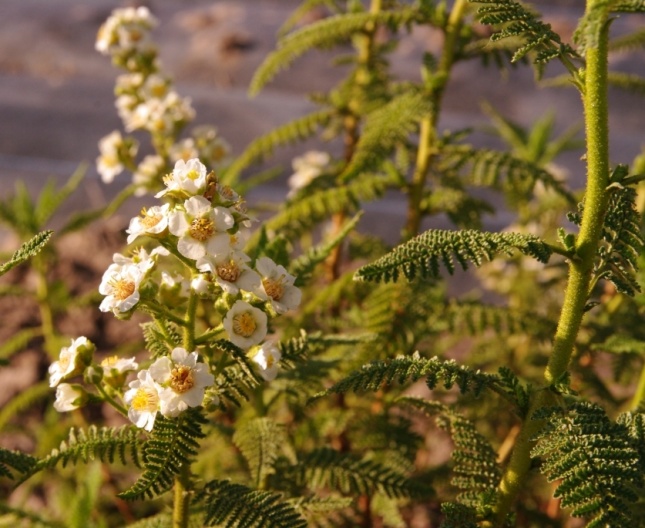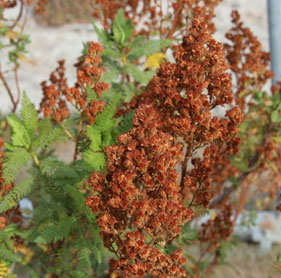Desert Fernbush in the Landscape


Stephen Love, University of Idaho
Scientfic Name: Chamaebatiaria millefoliumCommon Name: Fernbush, Desert Fernbush, Desert Sweet, Tansybush
Description: Desert fernbush is a striking landscape shrub with remarkable drought tolerance. Stems display reddish-brown bark that peels with age, the leaves are sticky and fern-like. Flowers are white, ½ inch in diameter, and have the form of single roses. The leaves can be evergreen in warmer climates but are deciduous where winters are cold. Northern ecotypes (Idaho, Oregon) of this species are small-statured (to 4 feet), with bright green leaves, and exhibit late spring bloom. Southern ecotypes (southern Utah, Arizona) of the species are often larger (up to 10 feet tall), have gray leaves, and exhibit late summer bloom. The unique appearance of this shrub makes it a superior xeric specimen plant for dry landscapes.
Native Habitat: Fernbush is native to dry areas of the northern Rocky Mountain states, northern California, and northern Arizona. Plants grow in very rocky places within tall desert scrub communities and sometimes are found on desolate lava flows. Generally found at elevations ranging from 4,000 to 7,000 feet.
Cultural Requirement
Soil: Requires a well-drained site but tolerates most soil types, including those with high pH. May exhibit wilt symptoms if planted in soil containing the soil-borne pathogens commonly found in places with a long history of cultivation.
Moisture Tolerance: Drought tolerant and survives extremely xeric conditions. In the landscape this species may benefit from an occasional deep irrigation to maintain the beauty of the leaves and flowers.
Sun/Shade/Preference: Requires full sun.
Transplanting: Handling desert fernbush can be somewhat frustrating and some losses can be expected when transplanting from pot to pot. Transplanting to the garden is easier, with high rates of survival. Plants develop rapidly, tolerate pot culture if grown in well-drained media and are not over-watered. Maintain excellent appearance in pots up to 5-gallon size.
Propagation: Very easily propagated from seed. Cold-moist stratification for 3 to 4 weeks will enhance germination but is not absolutely required. Seedlings are very susceptible to damping-off, which is likely the cause of the majority of transplant problems. Control damping-off by mulching the soil with pea gravel, avoiding overcrowding of plants in germination trays, maintaining good airflow around flats, and avoiding overwatering. Fernbush can be propagated using rooted stem cuttings, but the ease of seed propagation makes this process unnecessary.
Maintenance (pruning, fertilization, deadheading, division, irrigation, etc): Routine spring and summer pruning is required to remove aging interior branches, increase foliage density, and improve form. Plants are amenable to sheering and can also be re-invigorated by cutting back to the crown and allowing regrowth. Fernbush will benefit from deep irrigation once or twice each summer. A small amount of nitrogen fertilizer may be applied to invigorate plants, but is seldom required.
Insect, disease, or other problems: Desert fernbush has few insect or disease issues. One exception is wilt disease when planted in soils with a history of cultivation. These diseases can be reduced by maintaining xeric conditions, ensuring proper drainage, or planting into soils obtained from native desert locations.
Landscape Value
Use in the Landscape: Desert fernbush is an outstanding specimen plant for any dry landscape. It can also be effective in a mixed bed or border. It is one of the best plants available for creating a water-conserving formal garden.
Foliage: The most prominent characteristic of fernbush is the finely divided, fern-like leaves. The leaves are semi-evergreen and resinous with a strong, though not unpleasant, fragrance. Branches are supple, relatively slender, red-brown, and exhibit peeling bark when mature. Foliage covers the plants to ground level, creating a mounded or open-spreading appearance, depending on the ecotype.
Flower: Flowers have five petals, are ½ inch in diameter, bright white in color, and typical in form to most species in the rose family, of which it is a part. Bloom last for up to six weeks, a lengthy period for a shrub that flowers only once per year. Northern ecotypes bloom in June and early July. Southern ecotypes bloom late July into September.
Timing: June-September
Fruit: The fruit is a dry, papery capsule that opens to release numerous small, yellow, banana-shaped seeds. As they age, the numerous seed heads become copper colored and add to the aesthetic value of the plants.
Form: Medium-sized shrub with loosely mounding to open spreading form.
Texture: Fine to medium, depending on time of year.
Ultimate Size: Mature size is dependent on ecotype. Northern ecotypes are usually up to 4 feet tall with similar spread. Southern ecotypes may be similar in size to their northern cousins, but are often more robust, reaching heights and spreads of up to 10 feet.
Rate of Growth: Once established, fernbush grows very rapidly. Even though still relatively small, plants grown from seed will often bloom before the first summer is over. Ornamental value in the landscape is immediate, the product of the unusual and attractive foliage.
Suggested Plant Partners: Desert fernbush can be mixed with plants showing limited color range to create a monochromatic effect, or with highly colored complementary perennials. Partner with other xeric shrubs such as Fallugia paradoxa, Rhus trilobata, and Yucca baccata. Use with any number of dry-land perennials, including Mirabilis multiflora, Verbena stricta, Sphaeralcea munroana, Potentilla thurberi, Penstemon barbatus, Eriogonum racemosum, and Berlandiera lyrata.
Availability: Occasionally available as potted plants from native-plant nurseries. Seed can be obtained from native-plant seed suppliers.
Cultivars: None.
References:

